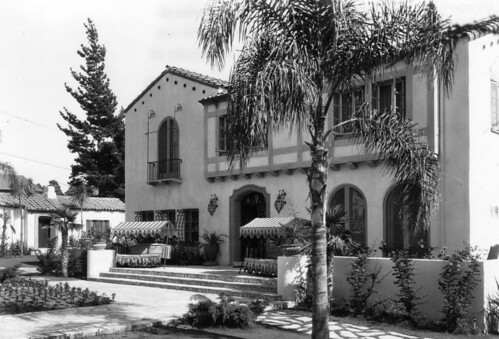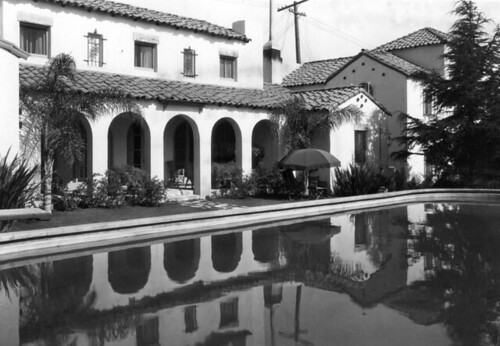Hollywood in its Golden Age was filled with beautiful, glamorous apartments, residence hotels and bungalow courts, quite a few of which have survived the harsh winds of time, neglect, temblors and the questionable taste of subsequent owners.
But the site of that most storied of all the Hollywood residences, the legendary Garden of Allah (8152 Sunset Boulevard), is today a bland mini-mall anchored by a McDonald’s restaurant in the post-modern style. Popular myth has it that it was demolition of the Garden of Allah and its beautiful pool and fountains, mature gardens, handsome villas and culture of creativity that inspired Joni Mitchell to write “Big Yellow Taxi” — “they paved paradise, put up a parking lot.” If that isn’t true, it ought to be. 
Photo: Los Angeles Public Library
The Garden of Allah fell to the wrecker in summer 1959. But on April 9, 1940, when the census enumerator dropped by to take the hotel’s temperature, it was at its height as an urbane social center, the only place suitable for a certain class of extraordinary person to make their Hollywood home.
The census record is illuminating and more than a little heartbreaking as a suggestive portrait of a vanished time. The first resident recorded is practically a novel in a single line:
Lerner, Herbert A. White, single, Louisiana-born, 29. His residence on April 1, 1935? ” At sea. Near Florida” Occupation? “First mate, private yacht.” Annual wages $1200.
This is the type of fascinating stranger one might make a friend of at the famous bar at the Garden of Allah. No wonder writers loved the place.
And yes, there are famous writers living at the Garden of Allah in the spring of 1940, and we’ll get to them, but just look at the variety of elevated humanity that was drawn to this seductive corner of the world.
A stock broker. A public utilities executive. A couple guys in advertising. Varied and sundry magazine hacks. A night club publicity manager. An actors’ agent. Alonzo F. Farrow and wife Edna, who run the joint ($3600/year for him). British film producer John Stafford. The beautiful Greta Nissen, a silent star that fell from favor, though not entirely, due to her strong Norwegian accent. Populist historian and pulp writer Harold Lamb, who must have been a hoot over a cup of grog. Irish novelist Liam O’Flaherty, slumming with film work. Edwin Justus Mayer, who wrote To Be or Not To Be.
And mostly clustered together near the bottom of the page, those grand Algonquin wits. George S. Kaufman, theatrical writer, 50, who declined to state his income. Robert C. Benchley, motion picture writer, $5000+ per annum. Alan Campbell and wife Dorothy P., for Parker, both movie writers, both earning what friend Benchley brings home. This was where the hard work got done, and steam was let off, before the cycle began again. What nights they must have had, and what days, beneath the ridiculous California sun, surrounded by geniuses and nincompoops, the lovely and the lost.
Once upon a time in Hollywood, this place was real, not imagined. Now it’s just real estate, a ring of shaggy palm trees around an asphalt lot. Pull in some time, park in the center, close your eyes and just breathe the air that once fed paradise. That grand moment has passed, and this moment can be rude and trying. But a more beautiful world is coming. It was ever thus.
Photo: Los Angeles Public Library

